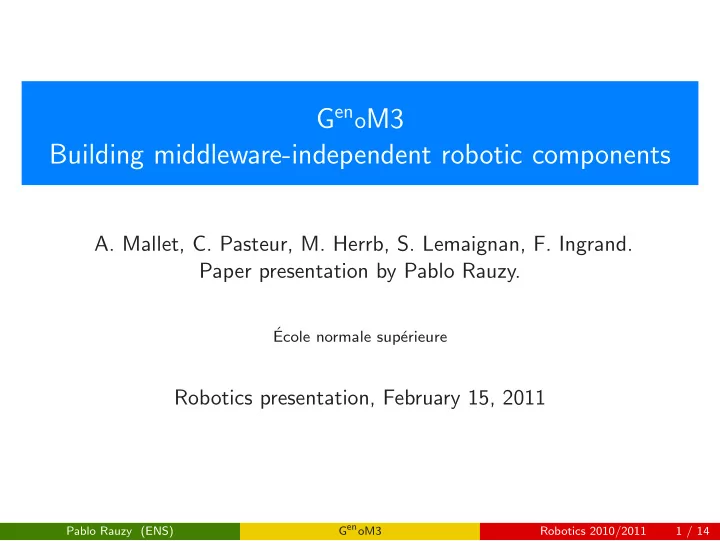

G en o M3 Building middleware-independent robotic components A. Mallet, C. Pasteur, M. Herrb, S. Lemaignan, F. Ingrand. Paper presentation by Pablo Rauzy. ´ Ecole normale sup´ erieure Robotics presentation, February 15, 2011 G en oM3 Pablo Rauzy (ENS) Robotics 2010/2011 1 / 14
Introduction The problem ◮ Need for reusable code ◮ ... at every level G en oM3 Pablo Rauzy (ENS) Robotics 2010/2011 2 / 14
Introduction The solution ◮ Software engineering approach ◮ ... at every level G en oM3 Pablo Rauzy (ENS) Robotics 2010/2011 2 / 14
Introduction How? ◮ Classical software engineering and architecture for high level code ◮ A component based architecture ◮ An efficient way to abstract middleware (this is what was missing) G en oM3 Pablo Rauzy (ENS) Robotics 2010/2011 2 / 14
Abstracting middleware? G en oM3 Pablo Rauzy (ENS) Robotics 2010/2011 3 / 14
Abstracting middleware? G en oM3 Pablo Rauzy (ENS) Robotics 2010/2011 3 / 14
Abstracting middleware? G en oM3 Pablo Rauzy (ENS) Robotics 2010/2011 3 / 14
Abstracting middleware! G en oM3 Pablo Rauzy (ENS) Robotics 2010/2011 4 / 14
Abstracting middleware! G en oM3 Pablo Rauzy (ENS) Robotics 2010/2011 4 / 14
An overview of the G en o M3 workflow G en oM3 Pablo Rauzy (ENS) Robotics 2010/2011 5 / 14
G en o M3 usage Glue ◮ Link the library and the middleware together ◮ Middleware independance is deferred to the sole glue software ◮ Separation of concerns between the algorithmic core and the middleware ◮ Generated automatically! G en oM3 Pablo Rauzy (ENS) Robotics 2010/2011 6 / 14
G en o M3 usage Component templates ◮ Contains all the code that is not part of the algorithmic core of any specific component ◮ Only one template is required for a given middleware ◮ Yet, different templates allow to switch easily between alternative architecture ◮ Developped in any language, using the whole language G en oM3 Pablo Rauzy (ENS) Robotics 2010/2011 6 / 14
G en o M3 usage Component description file ◮ Contains all the necessary information to describe the component ◮ G en o M3 parser builds an AST and converts it into a suitable representation for the scripting language of the template interpreter Data in component description files ◮ Data types used in the interface ◮ Meta-data (language, internal data structure) ◮ Data ports and events ◮ Tasks ◮ Services G en oM3 Pablo Rauzy (ENS) Robotics 2010/2011 6 / 14
G en o M3 usage Codels ◮ Set of individual functions, performing only elementary actions ◮ No different from any regular library G en oM3 Pablo Rauzy (ENS) Robotics 2010/2011 6 / 14
Comparing frameworks: YARP, MS Robotics Dev Studio, URBI, OpenRTM-aist, ROS G en oM3 Pablo Rauzy (ENS) Robotics 2010/2011 7 / 14
Comparing frameworks YARP ◮ Collection of programs which communicates (strong focus on communication) ◮ C++ ◮ Designed for research ◮ ROS compatible G en oM3 Pablo Rauzy (ENS) Robotics 2010/2011 8 / 14
Comparing frameworks Microsoft Robotics Dev Studio ◮ Non-free (as in freedom)! ◮ Windows only ◮ C# or VPL (visual programming) / .NET ◮ Fullstack IDE + advanced simulator ◮ Natively work with a lot of commercial robots (incl. NXT) G en oM3 Pablo Rauzy (ENS) Robotics 2010/2011 9 / 14
Comparing frameworks URBI ◮ Component based ◮ C++ UObject orchestrated by urbiscript DSL ◮ Parallelism for free ◮ Easy event-based programming ◮ Advanced flow control using tags ◮ ROS compatible G en oM3 Pablo Rauzy (ENS) Robotics 2010/2011 10 / 14
Comparing frameworks OpenRTM-aist ◮ Component oriented ◮ C++ / Java / Python ◮ ROS compatible G en oM3 Pablo Rauzy (ENS) Robotics 2010/2011 11 / 14
Comparing frameworks ROS ◮ Full OS ◮ Control low level too ◮ Notion of nodes (similar to “components”) ◮ C++, Python and ROS ◮ Seems to be the reference G en oM3 Pablo Rauzy (ENS) Robotics 2010/2011 12 / 14
Comparing frameworks Conclusion ROS wins? G en oM3 Pablo Rauzy (ENS) Robotics 2010/2011 13 / 14
The end Questions? G en oM3 Pablo Rauzy (ENS) Robotics 2010/2011 14 / 14
Recommend
More recommend